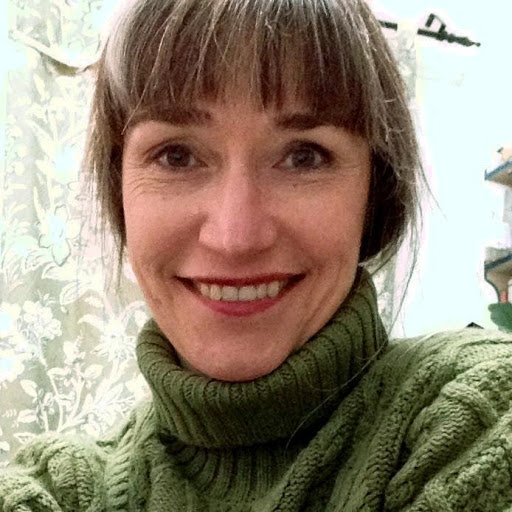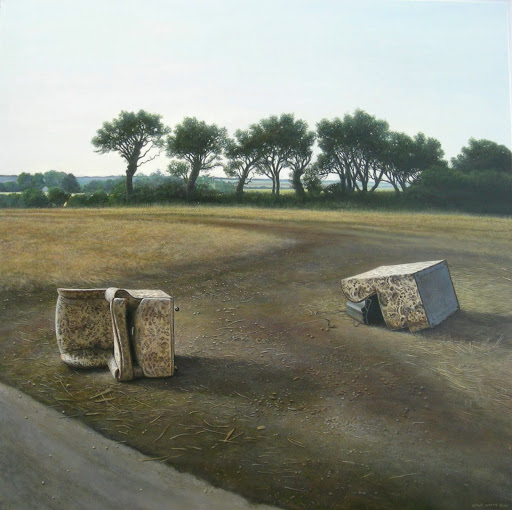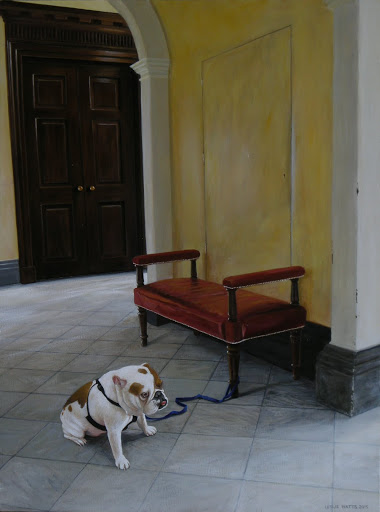Artist of the Month: Leslie Watts
I was introduced to Leslie Watts, the amazing figurative painter, by the owner of Wandering Educators and am I glad I was! When I went to her website, I was filled with delight. Her work is humorous, whimsical, and highly detailed. It is wonderful - and I think you will say the same thing.
Leslie not only paints into the wee hours of the morning, but she also privately teaches in her home studio. Many artists teach in workshop form, but with Leslie, the lessons are private. Her life in Stratford, Ontario, Canada sounds beautiful and her work is available through her gallery, Village Studios, there.
You are so going to enjoy the work of Leslie Watts, and I am guessing you will finish reading this interview with a smile on your face. Thank you, Leslie, for being our Artist of the Month at Wandering Educators.

How long have you been an artist?
I have been a professional artist since 1985, although I began to draw and paint while I was a small child. I graduated from York University in Toronto in 1984 with an Honours BA in Psychology. I then spent a year in Italy, writing and illustrating a children's book. When I returned to Canada, I visited several publishers with my portfolio and began to work as a professional illustrator.
Although I made a career of both writing and illustrating for a couple of decades, I started selling original art in 1996 when my marriage ended, and I needed other means of supporting myself. I finally decided in 2007 to stop doing commercial work entirely and to focus solely on making original fine art.

Thirteen Apples

Drawing Room
Where do you work? How long have you been there?
Since then, I have made art my full-time career. I moved to Stratford, Ontario in 2004. My studio is in my house. It's a small space, less than eight feet square, but it is well lit and has everything I need, including my easel and computers. I have a separate room with a sink for clean-up and storage for supplies such as canvases, boards, and extra paints.

Library

Happy Hour

Still Life with Scarlet Tanager
What does a typical day look like? Is there a typical day?
Now that my two children have grown up and moved away, I've discovered to my surprise that I like to work well into the night. I'm a bit obsessive where my work is concerned. I don't set my alarm, but I tend to wake up about nine or ten in the morning. After I shower and eat my breakfast, I dawdle over email and Twitter, and finally get to work some time after noon. After that I put in at least twelve hours in the studio.

Chapel
It's not unusual for me to work until two in the morning. I do take breaks for meals and to take the dogs out. But I'm happiest when I'm in my studio working. In order to keep myself going during the boring bits, I listen to audio books or BBC Radio on the internet. Sometimes I'll have Netflix on – as long as the films or tv programs have a lot of dialogue and I can listen without watching too much. I don't listen to much music, because I find that I start to think about myself too much, and that is actually a barrier to working. The best work comes when I have an interesting story or program to think about, and the act of painting becomes almost subconscious.

Study in Black and White
On Tuesdays and Thursdays, I have private students come to my house for lessons. I teach four ninety-minute classes a week to three or four students at a time. My students range in age from early teens to late seventies. The income from these lessons gives me a small but steady income that allows me to spend my painting time without financial worries. Before I started teaching, I was always worried about money, because I never knew whether the paintings I was making would sell or not.

The Gardens at Hever
Luckily, I have discovered not only that I love to teach, but also that teaching makes me a better artist. Having to articulate to others what I have grown used to doing by instinct helps me when I'm having a difficult time with a particular painting. Spending time with my students also gives me time to re-energize myself through social contact. It is quite thrilling to see my students improving not only technically, but also in confidence. This past summer, five of my students had work accepted in the juried exhibition at Gallery Stratford, our local public art museum. I know that even if I didn't have to teach for financial reasons, I would still want to do it because I get so much joy from it.

Don’t miss our new Pimm’s cocktails
What materials do you prefer?
I have worked for many years in acrylic and egg tempera. Recently I've been working on a series of graphite and wax drawings on clay coated panels. But egg tempera is my true love. It's an ancient medium, predating oils, and it takes a very long time. Because it is so unusual, there are very few artists working in egg tempera. This is part of its appeal for me. Through application of dozens, if not hundreds, of layers, egg tempera has a luminosity that cannot be matched by other media. It is made by mixing egg yolk, water, and dry pigments. I've been working on a how-to website here: http://lesliewattseggtempera.weebly.com/

Hawthorn
In 2013, I decided that I wanted to enter the BP Portrait Award, an annual international competition held at the National Portrait Gallery in London, UK. Since then, I've been fortunate to have three of my portraits included in this exhibition. These have all been executed in egg tempera. Because of my inclusion in this show, I've had the opportunity to meet other portrait painters, and I'm now in regular correspondence, mainly through Twitter, with a number of extremely accomplished artists. I find that this helps me in my own practice, since I'm now able to exchange technical information with artists whose work I greatly admire. It's also quite wonderful to be in contact with other artists in the studio while I'm at work, even if it's only to share a joke. I've made some good friends overseas through the BP Portrait Award.

Pamela Newel Sellers

Stefan, 23

Charlotte and Emily
I don't only paint portraits, however. I also paint landscapes, interiors, and still lifes. In recent years, I've worked on a series of surreal paintings in which I've placed people or animals in unexpected places. I love painting decorative interiors, so when I've had the opportunity to visit museums in London, I've photographed rooms that I've later used in paintings. I'm inspired by seeing odd things. For instance, while on a walking tour near Dover, on England's east coast, I came across some chairs and a television that had been tossed into a field. I knew as soon as saw them that I'd make a painting of this scene.

Chairs in a Field
Sometimes I just play with photographs that I've taken, adding people or animals that weren't there to begin with, and when the photo makes me laugh, I know that I can make a painting from it. I don't think that art must always be serious. I can be just as inspired by a humorous idea as by a beautiful scene. However, I decided when I started to paint full time that my one criterion was that each painting must be beautiful, even if the subject matter was not. So I work very hard at creating art that has its own intrinsic beauty.

Dora Steps Out
How do you know when your piece is done?
I know that a painting is done when there is nothing more I can do to improve it. It doesn't matter whether it's perfect; it never will be. I just have to know that I've given it my best. Sometimes I'll sign a painting because I believe that it's finished. Then I stand back and take another look. If I then actually believe it's finished, I'll leave it alone. But sometimes the signature helps me to see that there is one small last thing that needs to be tweaked before it's right.

Grand Staircase

Cheap Thrills
Do you work on one or more pieces at a time?
When I was a children's book illustrator, I learned to work on sixteen or more paintings at one time. This has become a habit. So when I'm preparing for a show, I tend to start all the paintings I intend to finish before I stop working on any one piece. Once the sixteen or so paintings are begun, I work on one until I run into a problem, and then I put it aside. I may keep it propped up in my studio so that I can take a look at it every once in awhile. Often a problem can be solved in my head before I solve it with my hand. I find this method keeps me from spinning my wheels while I'm working to a deadline. I just keep working on the paintings, a little at a time, until they are all done. The only exception to this comes when I'm painting a portrait for a competition. In that case, I work on only the portrait until it is done. I find that the thought of competing with other artists is enough incentive to keep me at it until I'm satisfied, although sometimes the process is extremely difficult. When I'm preparing for a show of many pieces, I'm only trying to be better than my own previous work. Because it's my job, I have to create art that is appealing enough to sell. I have complete control over the subject matter and the execution, and it has to look good to me first, but eventually it will be hung in a gallery, so ultimately it also has to look good enough to the buyers of art as well.

Waiting at the Wallace
How can our readers find and purchase your art?
I've been fortunate to be represented in Stratford for many years by Village Studios. My dealer, Martha Courtney, has been holding annual shows for me since 2008. If people want to purchase my work, I post all of the work for sale at Village Studios on my blog, www.lesliewatts.blogspot.ca. The work ranges in price from a few hundred dollars for a small painting to $5,000 Canadian for a large acrylic on panel. Portraits start at $6,000, although I am fully booked for commissions for the next few years. I also have a website, www.lesliewatts.ca where I've posted my artist statement, my CV, and the best examples of my paintings from recent years.

A Day at Hever Castle

Private Entrance
Kim Rodeffer Funk is the Art Editor for Wandering Educators. She notes, "I am an abstract painter and have enjoyed living a creative life for many years. In 2012, I co-founded Atelier 325 with Andrea Hupke de Palacio, and today show my art in Europe and the United States."
You can find her at http://www.kimrodefferfunk.net/
All photos courtesy and copyright Leslie Watts




















